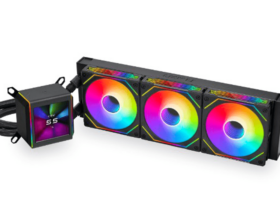In this article we will see the review of the Asus TUF Gaming RTX 3060 Ti OC. A video card that has managed to surprise us on several occasions
Asus has always got us used to Respectable custom VGA, but with this RTX 3060 Ti has really scored a great engineering work. The board in question, as you will discover during the review, could really agree with a considerable crowd of users. Imagine now being able to have a video card that is as strong as the flagship of the previous series, which costs half, which consumes about 20% less and that it is freezing even under stress. This, and more, is what the TUF version offered by the Taipei-based giant offers.
Now stop imagining why all of this is reality. We don’t want to go around it too much, the 3060 Ti signed Asus TUF surprised us, and it did it in a positive way. Let’s find out why!
Design and specifications | Asus TUF Gaming RTX 3060 Ti review
Before we start talking about design choices, let’s give a look at the technical specifications of this Asus TUF Gaming RTX 3060 Ti.
- Architecture: NVIDIA Ampere
- Memory: 8GB GDDR6
- Memory bus: 14 Gbps su bus a 256 bit
- Bandwidth: 448 GB/s
- PCI Express: v4.0
- Engine Clock;
- OC Mode – 1785 MHz (Boost Clock)
- Gaming Mode – 1755 MHz (Boost Clock)
- CUDA Core: 4864
- TMUs / ROPs: 152 / 80
- Tensor / RT Core: 152 / 38
- Video outputs: HDMI 2.1 (x2) – DisplayPort 1.4a (x3)
- Dimensions: 30.1 x 14.3 x 5.4cm
With Nvidia Ampere we are facing the most important generational leap ever made by the green team. It proved this with the flagship RTX 3090, and in the mid-to-high range, this RTX 3060 takes you the performance banner high. With the previous generation Nvidia had managed to do a great job with the 20 series, introducing the RTX architecture for the first time, and with very good performance. We think that today this new mid-range architecture succeeds in reach, and in some cases surpass, the performance of the direct “opponent”, the 2080 Super, with lower list prices. A sign of how Nvidia always seeks the best in terms of engineering.
This card boasts the same chip as its big sister RTX 3070, we are talking about the GA104 which Nvidia has slightly “neutered” in terms of CUDA Core, to differentiate the two. We therefore find 4864 CUDA core as you may have read from the specs, with a “native” TDP indicated by Nvidia for 200W. We have in this sheet the 8nm production process of Samsung, with a Advanced die produced at 392mm2. A truly complete and certainly long-lasting chip, thanks to your 17.4 billion transistors.
As you can see from the dimensions above, we are ahead of a fairly generous card, also thanks to the three fans made available by the card for cooling. Which boasts a respectable sector, and precisely with regard to the fans, a peculiarity (which we had already seen and appreciated in the past) is that relating to the rotation of the blades. Asus has decided to run one of the three fans (the central one) contrary to the other two. A motion this, that it helps to convey the air flow effectively, guaranteeing homogeneous air recirculation throughout the architecture, this option eliminates turbulence and excessive noise. A system that recalls along the lines of what Nvidia has patented for its Founders, the “flow through” design, with the air flowing along the PCB.
Connections are also not lacking, in fact we find well 2 HD 2.1 outputs and three DisplayPort 1.4a. The design of the board is very sober and there are no LEDs whatsoever except a small plate at the height of the power connector. Here too there is a small clarification to make; contrary to the choice made by Nvidia with its Founder Edition we find an 8 Pin connector and not from 12. Thanks to this choice we would also be facilitated in cable management. In fact, only one cable will be enough to power our VGA. To want to be extremely picky, it all affects not only the aesthetic factor, but also its dissipation. Heat that can be dissipated and, better expelled, from your case.
Furthermore, we also find a subtle difference between the fans themselves, as anticipated at the opening. Indeed the two lateral ones (left and right) have a CFM value (product air flow) equal to 44.16 CFM, unlike the central fan, equal to 46.03 CFMall this despite all spinning at a maximum speed of 3600 RPM. The last difference between the three lies in the logo, present on them. In fact, instead of rediscovering the logo TUF (as happens for the side ones) we find the writing Asus in the central fan.
Returning to the design of the board, the colors chosen are the classics of the TUF series. In fact, we find a great preponderance of gunmetal blacks and gray that give authority and style to the Asus TUF Gaming RTX 3060 Ti.
What else does Asus add compared to the Founders Edition?
While the 3060 Ti itself is a great card in the Founders Edition, we can’t help but appreciate the build quality, and the improvements that Asus has applied to this video card. The experience of the Asus engineers can be seen, and above all it is appreciated in the use of the same. Those looking for the best cannot fail to consider such an architecture.
Starting from the cooling system, profoundly different in terms of quality compared to the FE that in this TUF version of the 3060 Ti shows a back plate made entirely of metal. A rear opening structure, which allows a greater air flow and improves the cooling of the heat pipes. Also on the back plate there is a small switch that will allow us to make a switch between the two bios made available by Asus. A function that was once intended only for top-of-the-range models. The cooling system allows this GPU to flex its muscles in all conditions, without worrying about temperatures. Asus used proprietary Max Contact technology to ensure maniacal assembly. And to polish the heatsink surface and improve smoothness. All in favor of a better contact, with huge benefits on thermal transfer.
The components chosen for this VGA only really excellent quality, exactly in pure Asus style. We find in fact double ball bearings, capacitors and top quality MOSFETs, which go perfectly with the Auto-Extreme manufacturing process, for a PCB with incredible signal cleanliness. In short, we can only congratulate Asus for the choices of materials, engineering and design. But now it’s time to start talking about field tests!
C | Asus TUF Gaming RTX 3060 Ti review
In order to understand how this video card runs in the gaming field, we have worked to test it on various resolution formats. We tested the card in FHD, 2K and 4K.
For our tests we used the following configuration:
All video card results are obtained from the same system with exactly the same configuration. All games are set to their highest quality settings, unless otherwise noted. We would like to specify that performance may vary based on the type of configuration, we therefore send you to take such data inherent to our own system, and not as absolute values.
Every single game is tested at these screen resolutions:
- 1920 × 1080: Most common widescreen resolution for larger displays (22 “- 26”).
- 2560 × 1440: 2K resolution for commonly available displays (27 “-32”).
- 3840×2160: 4K Ultra HD resolution, available on the latest high-end monitors.
Performance at stake | Asus TUF Gaming RTX 3060 Ti review
Starting from the tests we carried out at the resolution of 1080p, we observe a truly excellent behavior of the 3060 Ti from Asus. We get a great result of 182 FPS su Forza Horizon 4, circa 146 FPS con Shadow Of The Tomb Raidere i 228 FPS con Doom Eternal, without ever falling into overheating of the GPU, and with the fans never having reached significant noise levels. With Assassin’s Creed Valhalla instead we got it 70 FPS and, with the title Flight Simulator we got approx 55 FPS.
Ma instead let’s move on to the tests performed at 1440p. Where even in this scenario TUF Gaming defended itself very well, with performances that compared to a 2080 Super are truly incredible. We obtain 153 FPS su Forza Horizon 4, circa 99 FPS con Shadow Of The Tomb Raider, e 183 FPS con Doom Eternal. Moving on Assassin’s Creed Valhalla instead we got 55 FPS while with the title Flight Simulator we mark 44 FPS. The performance with 4K resolution but always keeping the general level high. With Doom Eternal we got 97 FPS, go down to approx 24 FPS instead performance on Flight Simulator. With Assassin’s Creed Valhalla we got instead 40 FPS, with Shadow Of The Tomb Raider 53 FPS, while to conclude with Forza Horizon 4 we got 105 FPS.
We didn’t stop there, as we also ran the built-in benchmarks found in Shadow Of The Tomb Raider, Battlefield V and, Control titles. At the resolution of 1080p, 1440p and lastly in 4K. With RTX and DLSS active, here are the data summarized in this slide.

Always freezing temperatures | Asus TUF Gaming RTX 3060 Ti review
To demonstrate the great thermal management carried out by Asus, the data collected on temperatures highlighted the excellent management of the TUF in all conditions. The perception is that of an always reactive card, able to support any type of application, without hesitation, and without failing. The excellent dissipative management means that the GPU itself is more durable over time, and most importantly it allows the chip to keep the frequencies high.
Speaking of data, however, the temperatures measured during daily use they never exceeded 40/43 degrees. To get off in idle conditions at 38 degrees. But the surprising data is that relating to gaming, where even following long gaming sessions, we do not have never exceeded 60 degrees, truly an incredible result. Only during the benchmarks did we hit 65 degrees, but those conditions are relatively difficult to replicate in everyday life. Not to mention that even 65 degrees is an incredible figure. Congratulations certainly go to Asus for these great results.
The conclusions
So what to say about this Asus TUF Gaming RTX 3060 Ti, we certainly believe it a much better choice than the Founders Edition, certainly (the latter) will not give you these temperatures and this structure also suitable for applying overclocking profiles without problems present in this TUF. Asus TUF Gaming RTX 3060 Ti boasts in our opinion a really interesting value for money, for a silent, efficient card, excellent for work with professional software, and that does not fear resolution, and always comes out with head held high from every test.
Asus TUF Gaming RTX 3060 Ti is a model to consider in the medium-high range. This is a card that we feel like …














